Hua C., Wong R. Differential Equations and Asymptotic Theory in Mathematical Physics
Подождите немного. Документ загружается.

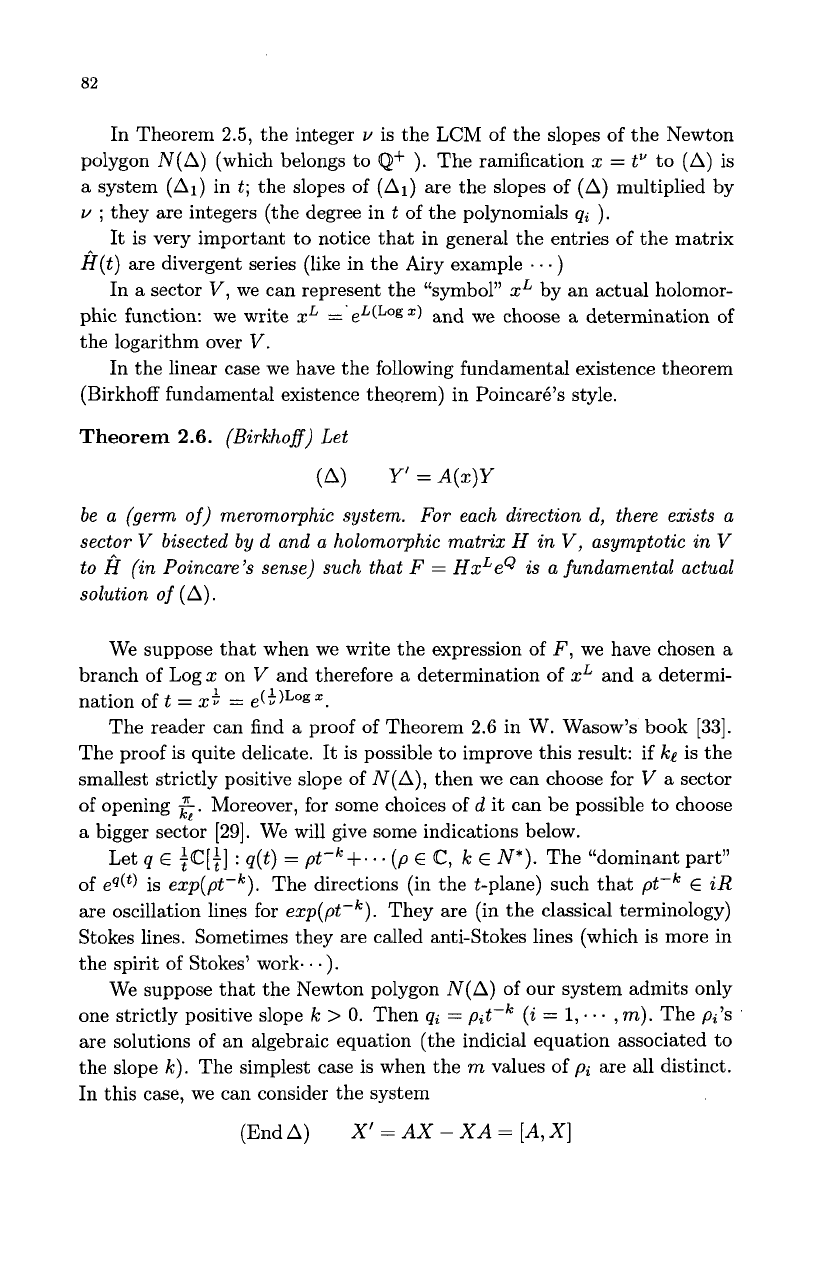
82
In Theorem
2.5,
the integer
v
is the
LCM
of the slopes of the Newton
polygon
N(A)
(which belongs to
Q+
).
The ramification
x
=
t’
to
(A)
is
a system
(A,)
in
t;
the slopes of
(A,)
are the slopes of
(A)
multiplied by
v
;
they are integers (the degree in
t
of the polynomials
qi
).
It
is very important to notice that in general the entries of the matrix
H(t)
are divergent series (like in the Airy example
. . .
)
In a sector
V,
we can represent the “symbol”
xL
by an actual holomor-
phic function: we write
xL
and we choose a determination of
the logarithm over
V.
In the linear case we have the following fundamental existence theorem
(Birkhoff fundamental existence theqrem) in PoincarB’s style.
Theorem
2.6.
(Birkhoff) Let
(A)
Y’=A(x)Y
be a (germ
of)
meromorphic system. For each direction d, there exists a
sector
V
bisected by d and a holomorphic matrix H
in
V,
asymptotic
in
V
to H (in Poincare’s sense) such that F
=
HxLeQ
is
a fundamental actual
solution
of
(A).
We suppose that when we write the expression of
F,
we have chosen a
branch
of
Logx on
V
and therefore
a
determination of
xL
and
a
determi-
The reader can find a proof of Theorem
2.6
in W. Wasow’s book
[33].
The proof is quite delicate.
It
is possible to improve this result: if
ke
is the
smallest strictly positive slope of
N(A),
then we can choose for
V
a
sector
of opening
2.
Moreover, for some choices of
d
it can be possible to choose
a bigger sector
[29].
We will give some indications below.
Let
q
E
$[+I
:
q(t)
=
pt-’++.
(p
E
C,
k
E
N*).
The “dominant part”
of
eq(t)
is
exp(pt-’).
The directions (in the t-plane) such that
pt-’
E
iR
are oscillation lines for
exp(pt-’).
They are (in the classical terminology)
Stokes lines. Sometimes they are called anti-Stokes lines (which is more in
the spirit of Stokes’ work.
. .
).
We suppose that the Newton polygon
N(A)
of
our
system admits only
one strictly positive slope
k
>
0.
Then
qi
=
pzt-‘
(i
=
1,.
.
. ,
rn).
The
pi’s
are solutions of an algebraic equation (the indicia1 equation associated to
the slope
k).
The simplest case is when the
rn
values of
pi
are all distinct.
In this case, we can consider the system
nation of
t
=
xt
=
e(t)Logz.
(End
A)
X’
=
AX
-
XA
=
[A,
X]
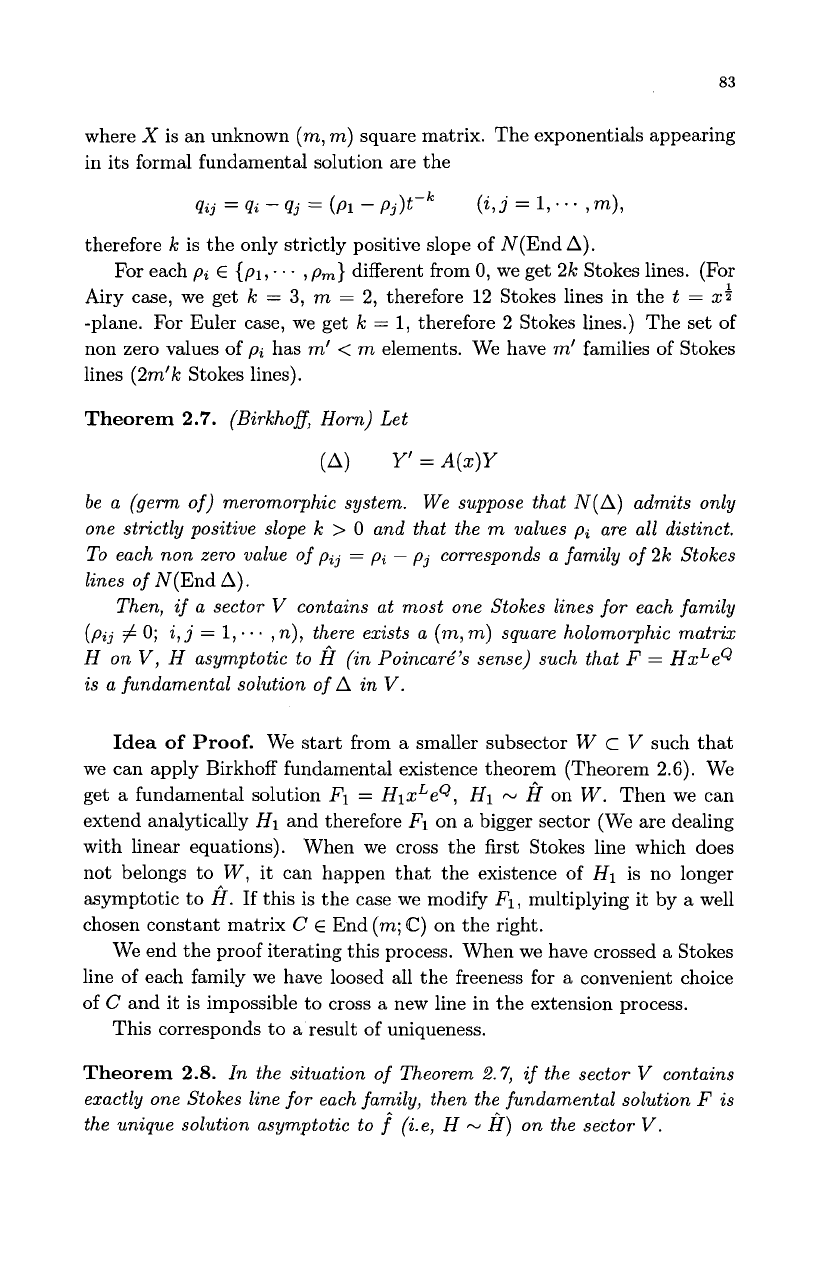
83
where
X
is an unknown
(m,
m)
square matrix. The exponentials appearing
in its formal fundamental solution are the
qij
=
qi
-
qj
=
(pl
-
pj)t-k
(i,
j
=
1,
. . .
,
m),
therefore
k
is the only strictly positive slope of N(EndA).
For each
pi
E
{PI,.
.
.
,
pm}
different
from
0,
we get
2k
Stokes lines. (For
Airy case, we get
k
=
3,
m
=
2,
therefore
12
Stokes lines in the
t
=
xi
-plane. For Euler case, we get
k
=
1,
therefore
2
Stokes lines.) The set of
non zero values of
pi
has
m’
<
m
elements. We have
m’
families of Stokes
lines
(2m’k
Stokes lines).
Theorem
2.7.
(Birkhoff,
Horn)
Let
(A)
Y’=A(x)Y
be a (gem
of)
meromorphic system. We suppose that
N(A)
admits only
one strictly positive slope k
>
0
and that the
m
values
pi
are all distinct.
To each non zero value
of
pij
=
pi
-
pj
corresponds a family
of
2k Stokes
lines
of
N(End
A).
Then,
if
a sector
V
contains at most one Stokes lines
for
each family
(pij
#
0;
i,j
=
l,...
,n),
there exists a
(m,m)
square holomorphic matrix
H on
V,
H asymptotic to
H
(in PoincarL’s sense) such that
F
=
HxLeQ
is
a fundamental solution
of
A
in
V.
Idea
of
Proof.
We start from a smaller subsector
W
c
V
such that
we can apply Birkhoff fundamental existence theorem (Theorem
2.6).
We
get
a
fundamental solution
F1
=
HlxLeQ, H1
-
H
on
W.
Then we can
extend analytically
HI
and therefore
Fl
on a bigger sector (We are dealing
with linear equations). When we cross the first Stokes line which does
not belongs to
W,
it can happen that the existence of
H1
is no longer
asymptotic to
A.
If
this is the case we modify
FI,
multiplying it by a well
chosen constant matrix
C
E
End
(m;
C)
on the right.
We end the proof iterating this process. When we have crossed a Stokes
line of each family we have loosed all the freeness for a convenient choice
of
C
and it is impossible to cross
a
new line in the extension process.
This corresponds to
a
result of uniqueness.
Theorem
2.8.
In
the situation
of
Theorem
2.7,
zf
the sector
V
contains
exactly one Stokes line
for
each family, then the fundamental solution
F
is
the unique solution asymptotic to
f
(i.e, H
-
H)
on the sector
V.
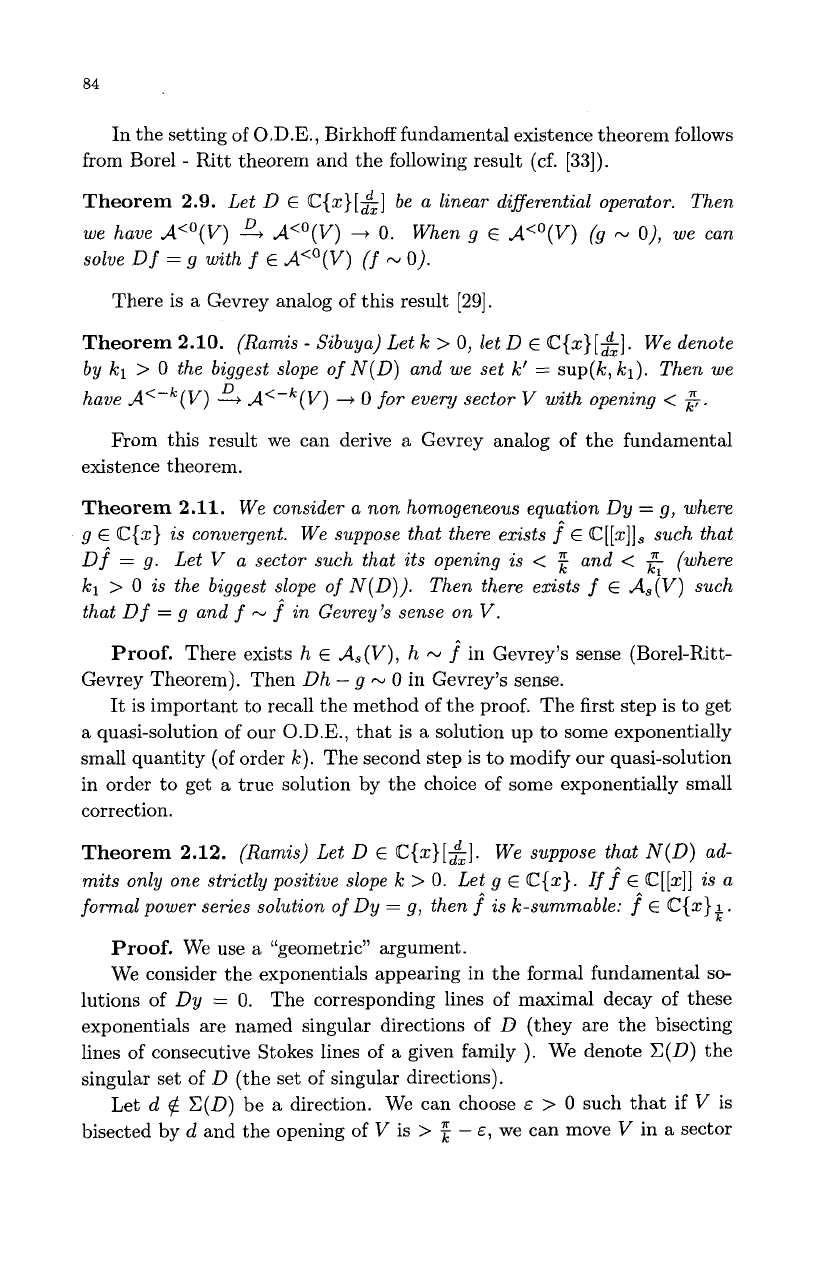
84
In the setting of
O,D.E.,
Birkhoff fundamental existence theorem follows
from Bore1
-
Ritt theorem and the following result (cf.
[33]).
Theorem 2.9.
Let
D
E
C{x}[&] be a linear differential operator. Then
we have
d<'(V)
-%
d<'(V)
+
0.
When
g
E
A<'(V)
(g
N
0),
we can
solve
Df
=
g with
f
E
A<O(V)
(f
N
0).
There is a Gevrey analog of this result
[29].
Theorem 2.10.
(Ramis
-
Sibuya) Let
k
>
0,
let
D
E
C{x}[&]. We denote
by
kl
>
0
the biggest slope
of
N(D)
and we set
k'
=
sup(lc,kl).
Then we
have
A<-'(V)
5
d<-'(V)
+
0
for
every sector
V
with opening
<
$.
From this result we can derive a Gevrey analog of the fundamental
existence theorem.
Theorem 2.11.
We consider a non homogeneous equation
Dy
=
g,
where
g
E,
C{x}
is convergent. We suppose that there exists
f
E
C[[x]], such that
Df
=
g.
Let
V
a sector such that its opening is
<
:
and
<
(where
kl
>
0
is the biggest slope
of
N(D)).
Then there exists
f
E
d,(V)
such
that
Df
=
g
and
f
N
f^
in
Gevrey's sense on
V.
Proof.
There exists
h
E
d,(V),
h
N
f^
in Gevrey's sense (Borel-Ritt-
Gevrey Theorem). Then
Dh
-
g
N
0
in Gevrey's sense.
It is important to recall the method of the proof. The first step is to get
a quasi-solution of our
O.D.E.,
that is a solution up to some exponentially
small quantity (of order
k).
The second step is to modify our quasi-solution
in order to get a true solution by the choice of some exponentially small
correction.
Theorem 2.12.
(Ramis) Let
D
E
C{x}[&]. We suppose that
N(D)
ad-
mits only one strictly positive slope
IC
>
0.
Let g
E
~{x}.
Iff
E
~[[x]]
is a
formal power series solution
of
Dy
=
g, then
f
is k-summable:
f
E
C{x}i.
Proof.
We use
a
"geometric" argument.
We consider the exponentials appearing in the formal fundamental
so-
lutions of
Dy
=
0.
The corresponding lines of maximal decay of these
exponentials are named singular directions
of
D
(they are the bisecting
lines of consecutive Stokes lines of a given family
).
We denote
C(D)
the
singular set of
D
(the set of singular directions).
Let
d
@
C(D)
be a direction. We can choose
E
>
0
such that if
V
is
bisected by
d
and the opening of
V
is
>
:
-
E,
we can move
V
in
a
sector
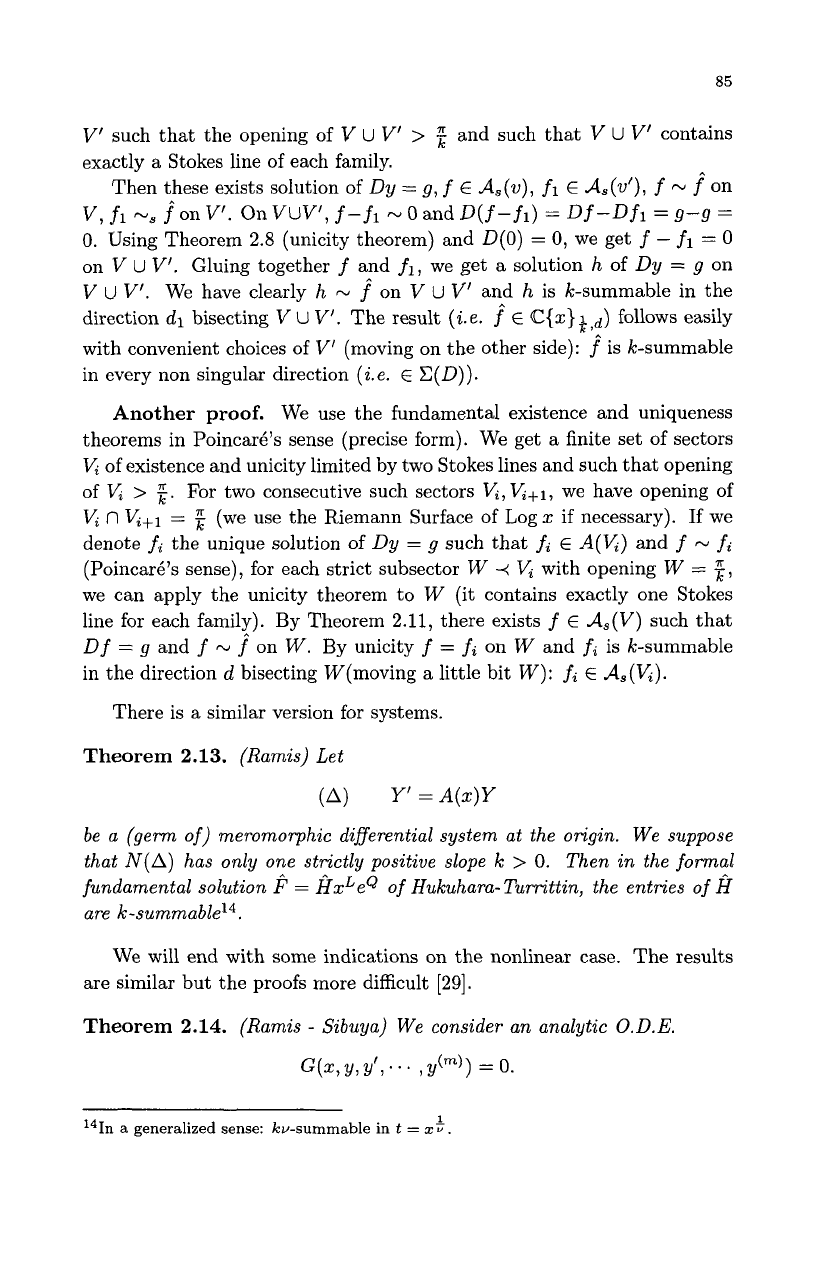
85
V’ such that the opening of
V
U
V’
>
2
and such that V
U
V‘ contains
exactly a Stokes line of each family.
Then these exists solution of
Dy
=
g,
f
E
d,(v),
f1
E
d,(v’),
f
N
f
on
V,
fl
N,
f
on V’. On VUV‘,
f-
fl
N
0
and
D(f
-
fl)
=
Df
-Dfi
=
9-9
=
0.
Using Theorem
2.8
(unicity theorem) and
D(0)
=
0,
we get
f
-
fi
=
0
on
V
u
V’. Gluing together
f
and
fl,
we get
a
solution
h
of
Dy
=
g
on
V
U
V’. We have clearly
h
N
f
on V
u
V’
and
h
is k-summable in the
direction
dl
bisecting V
U
V’. The result
(i.e.
f
E
C{X}~,~)
follows easily
with convenient choices of V’ (moving on the other side):
f^
is k-summable
in every non singular direction
(i.e.
E
C(D)).
Another
proof.
We use the fundamental existence and uniqueness
theorems in PoincarB’s sense (precise form). We get a finite set of sectors
V,
of existence and unicity limited by two Stokes lines and such that opening
of
V,
>
2.
For two consecutive such sectors
V,,
K+l,
we have opening of
V,
fl
V,+l
=
2
(we use the Riemann Surface
of
Log
z
if necessary).
If
we
denote
fi
the unique solution
of
Dy
=
g
such that
fi
E
A(V,)
and
f
N
fi
(PoincarB’s sense), for each strict subsector
W
4
V,
with opening
W
=
2,
we can apply the unicity theorem to
W
(it contains exactly one Stokes
line for each family). By Theorem
2.11,
there exists
f
E
d,(V) such that
Df
=
g
and
f
N
f^
on
W.
By unicity
f
=
fi
on
W
and
fi
is k-summable
in the direction
d
bisecting “(moving a little bit
W):
fi
E
d,(V,).
There is a similar version for systems.
Theorem
2.13.
(Ramis) Let
(A)
Y’=A(z)Y
be a (germ
of)
meromorphic differential system at the origin. We suppose
that
N(A)
has only one strictly positive slope
k
>
0.
Then
in
the formal
fundamental solution
F
=
HsLeQ
of
Hukuhara-Turrittin, the entries
of
H
are k-~ummable‘~.
We will end with some indications on the nonlinear case.
The results
are similar but the proofs more difficult
[29].
Theorem
2.14.
(Ramis
-
Sibuya) We consider an analytic
O.D.E.
‘*In
a generalized sense: Icv-summable in
t
=
zt
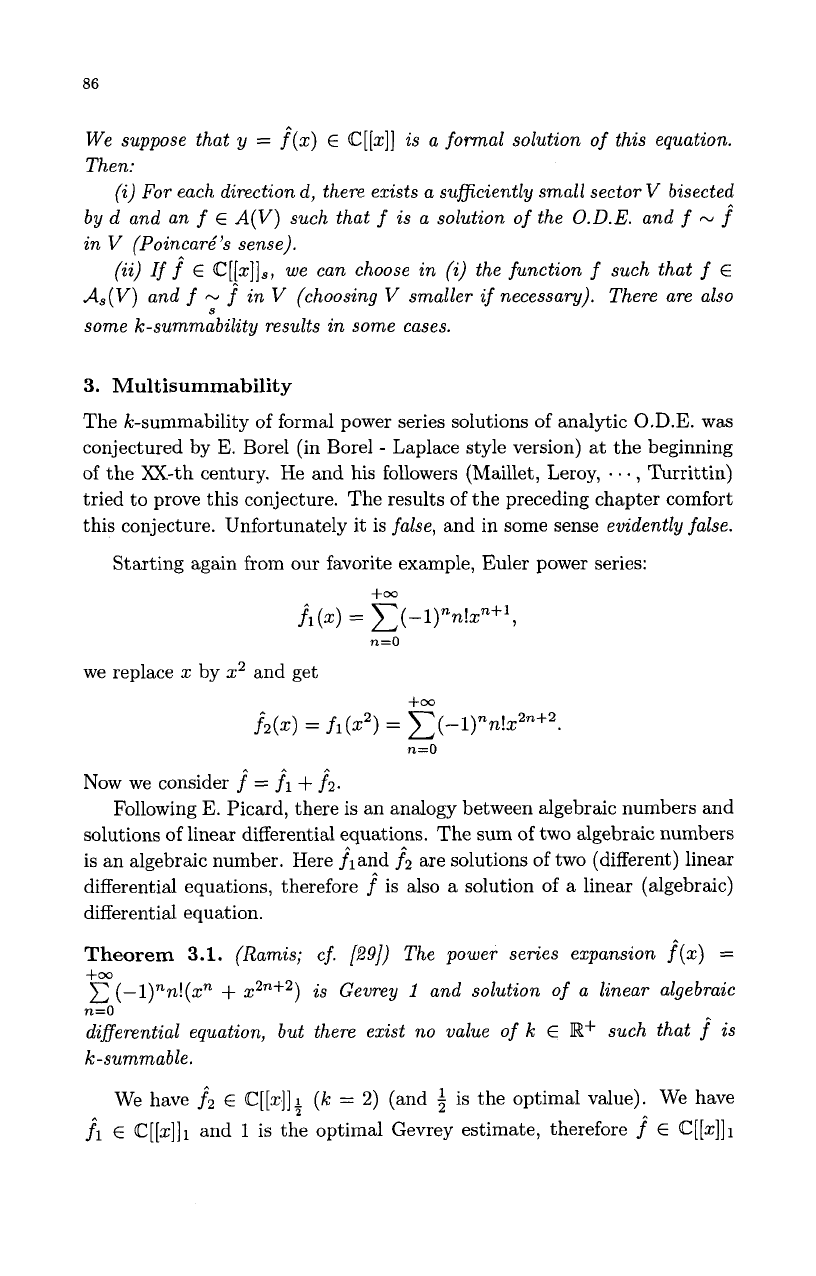
86
We suppose that
y
=
f”(x)
E
@[[XI]
is a formal solution
of
this equation.
Then:
(i)
For
each direction d, there exists a sufficiently small sector
V
bisected
by d and an
f
E
A(V)
such that
f
is a solution
of
the
O.D.E.
and
f
N
f”
in
V
(Poincare‘js sense).
(ii)
Iff”
E
@[[x]IS,
we can choose
in
(i)
the function
f
such that
f
E
d,(V)
and
f
N
f^
in
V
(choosing
V
smaller
if
necessary). There are also
some k-summability results
in
some cases.
S
3.
Multisummability
The k-summability of formal power series solutions of analytic
O.D.E.
was
conjectured by
E.
Borel (in Borel
-
Laplace style version) at the beginning
of the XX-th century. He and
his
followers (Maillet, Leroy,
.
. .
)
Turrittin)
tried to prove this conjecture. The results of the preceding chapter comfort
this conjecture. Unfortunately
it
is
false,
and in some sense
evidently false.
Starting again from our favorite example, Euler power series:
f”l(X)
=
-y(-l)nn!xn+l,
n=O
we replace
x
by
x2
and get
+oo
f2(.)
=
f1(X2)
=
C(-l)nn!x2n+?
n=D
Now we consider
f”
=
f”1
+
j2.
Following
E.
Picard, there is an analogy between algebraic numbers and
solutions
of
linear differential equations. The sum of two algebraic numbers
is an algebraic number. Here fland
f”2
are solutions of two (different) linear
differential equations, therefore
f”
is also a solution of
a
linear (algebraic)
differential equation.
Theorem
3.1.
(Ramis; cf.
1.291)
The power series expansion
f(x)
=
C
(-l)”n!(xn
+
x2n+2)
is Gevrey
1
and solution
of
a linear algebraic
differential equation, but there exist no value
of
k
E
R+
such that
f”
is
k-summable.
+oo
n=O
We have
f2
E
@[[XI]+
(k
=
2)
(and
3
is the optimal value). We have
f”1
E
@[[x]]1
and
1
is the optimal Gevrey estimate, therefore
f”
E
@[[x]]1
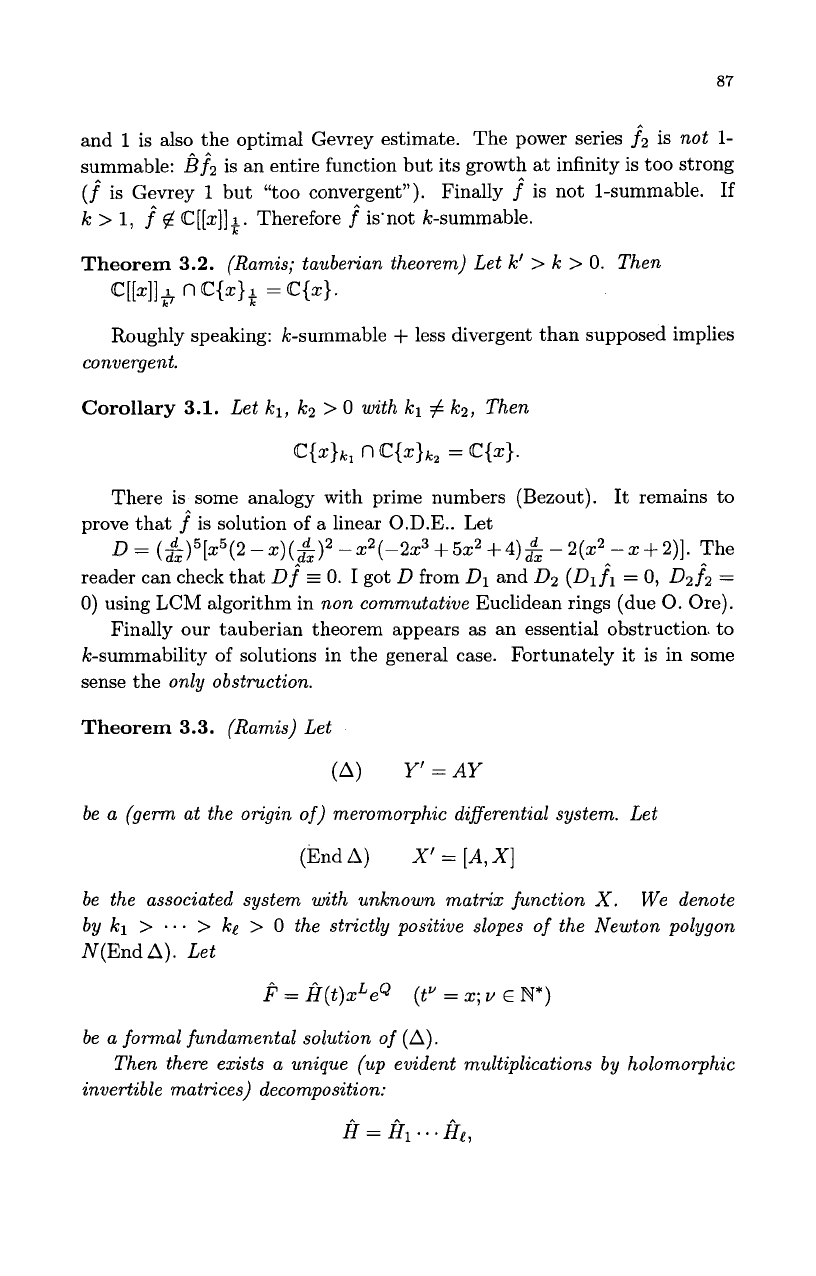
87
and
1
is also the optimal Gevrey estimate. The power series
f2
is
not
1-
summable:
Bf2
is an entire function but its growth at infinity is too strong
(f
is Gevrey
1
but “too convergent”). Finally
f
is not 1-summable.
If
k
>
1,
f
$!
cC[[z]];.
Therefore
f^
is‘not k-summable.
Theorem
3.2.
(Ramis; tauberian theorem) Let
k‘
>
k
>
0.
Then
C[[Z]]+.
n
c{+
=
c{+
Roughly speaking: k-summable
+
less divergent than supposed implies
convergent.
Corollary
3.1.
Let
kl,
kg
>
0
with
kl
#
k2,
Then
qz}/c,
n
qZ}kz
=
@{XI.
There is some analogy with prime numbers (Bezout).
It
remains to
prove that
f^
is solution
of
a linear O.D.E.. Let
reader can check that
Df
=
0. I
got
D
from
D1
and
02
(Dlf1
=
0,
D2f2
=
0)
using
LCM
algorithm in
non commutative
Euclidean rings (due
0.
Ore).
Finally
our
tauberian theorem appears as an essential obstruction. to
k-summability of solutions in the general case.
Fortunately it is in some
sense the
only obstruction.
D
=
(
z)
d55
[x
(2
-
x)
(
&)2
-
x2
(-2x3
+
5z2
+
4)
&
-
2(x2
-
IC
f
2)].
The
Theorem
3.3.
(Ramis) Let
(A)
Y’=
AY
be a (gem at the origin of) meromorphic differential system. Let
(End
A)
X’
=
[A,X]
be the associated system with unknown matrix function
X.
We denote
by
kl
>
...
>
ke
>
0
the strictly positive slopes of the Newton polygon
N(End
A).
Let
F
=
A(t)Z%Q
(t”
=
2;
v
E
N*)
be a formal fundamental solution
of
(A).
invertible matrices) decomposition:
Then there exists a unique (up evident multiplications by holomorphic
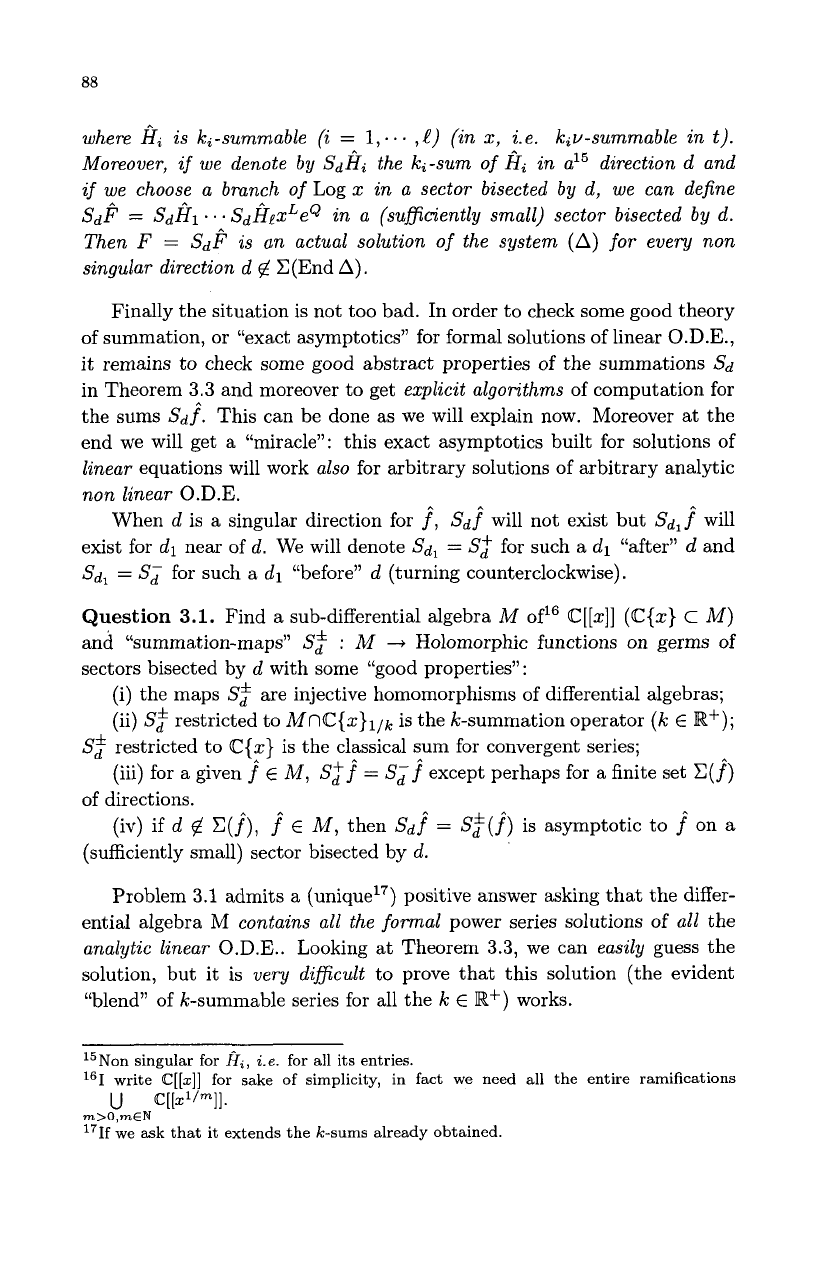
88
where
Hi
is ki-sumrnable (i
=
l,...
,t)
(in
x,
i.e. kp-summable
in
t).
Moreover,
if
we denote by
SdHi
the ki-sum
of
Hi
in
a15
direction
d
and
if
we choose
a
branch
of
Log
x
in
a
sector bisected by
d,
we can define
SdF
=
SdHl
’.
.
S&lxLeQ
in
a
(suficiently small) sector bisected by
d.
Then
F
=
SdF
is an actual solution
of
the system
(A)
for
every non
singular direction d
#
C(End
A).
Finally the situation is not too bad. In order to check some good theory
of summation, or “exact asymptotics” for formal solutions
of
linear O.D.E.,
it remains to check some good abstract properties
of
the summations
sd
in Theorem
3.3
and moreover to get
explicit algorithms
of computation for
the sums
Sdf.
This can be done as we will explain now. Moreover
at
the
end we will get a “miracle”: this exact asymptotics built for solutions of
linear
equations will work
also
for arbitrary solutions of arbitrary analytic
non linear
O.D.E.
When
d
is a singular direction for
f,
sdf”
will not exkt but
sdlf
will
exist for
dl
near of
d.
We will denote
Sd,
=
S:
for such a
dl
“after”
d
and
sdl
=
Si
for such
a
dl
“before”
d
(turning counterclockwise).
Question
3.1.
Find a sub-differential algebra
M
of16
@[[XI]
(@{x}
c
M)
and “summation-maps”
5’:
:
M
-+
Holomorphic functions on germs of
sectors bisected by
d
with some “good properties”:
(i) the maps
S:
are injective homomorphisms of differential algebras;
(ii)
S:
restricted to
MnC{x}l,k
is the k-summation operator
(k
E
R+);
(iii) for a given
f^
E
M,
S:f
=
Syf
except perhaps for a finite set
C(f)
(iv) if
d
@‘
c(f^),
f^
E
M,
then
sdf”
=
S$(f^)
is asymptotic to
f”
on
a
S:
restricted to
C{x}
is the classical sum for convergent series;
of directions.
(sufficiently small) sector bisected by
d.
Problem
3.1
admits a (unique17) positive answer asking that the differ-
ential algebra
M
contains all the
formal
power series solutions of
all
the
analytic linear
O.D.E.. Looking at Theorem
3.3,
we can
easily
guess the
solution, but it is
very difficult
to prove that this solution (the evident
“blend” of k-summable series for all the
k
E
EXf)
works.
15~on singular for
Hi,
i.e.
for all its entries.
161 write
C[[z]]
for sake of simplicity, in fact we
need
all the entire ramifications
m>O,mEN
171f we ask that it extends the
k-sums
already obtained.
u
C“zl’”1l.
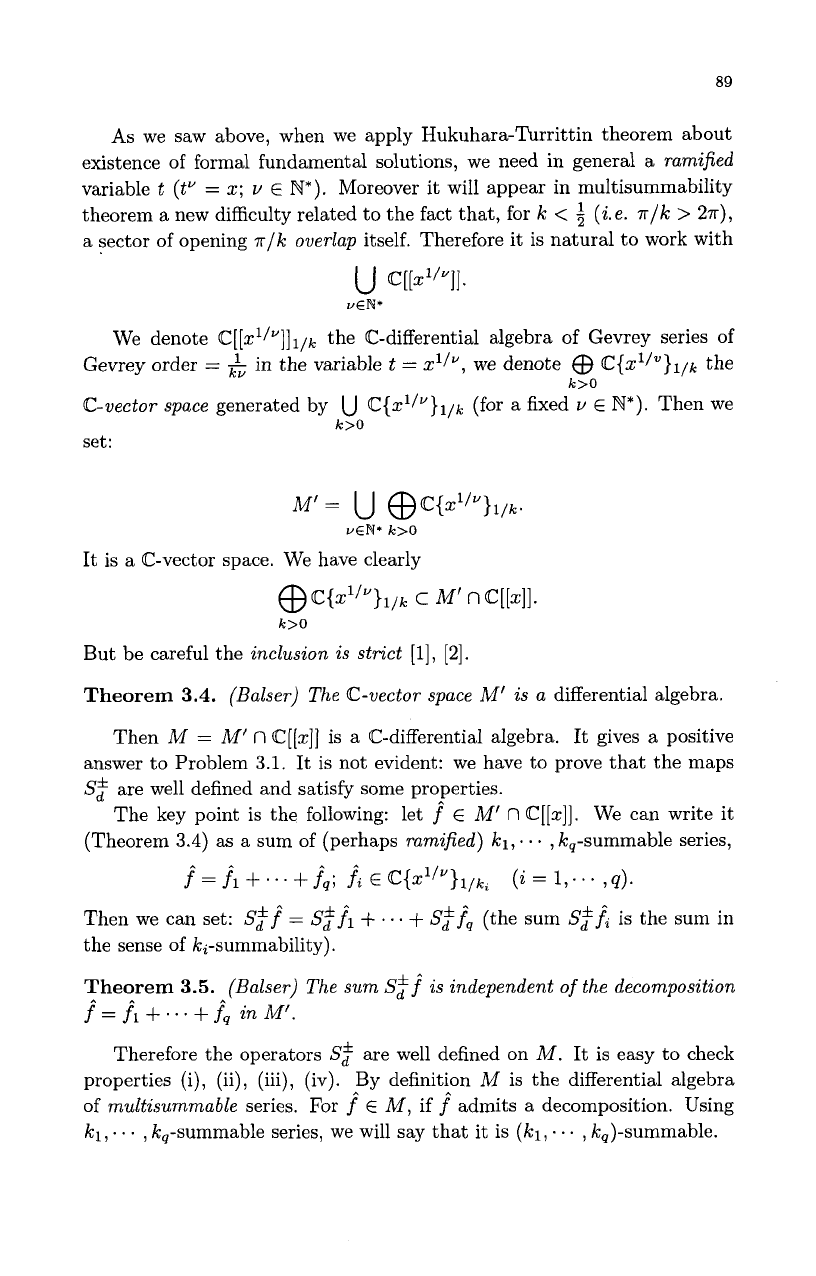
89
As
we saw above, when we apply Hukuhara-Turrittin theorem about
existence of formal fundamental solutions, we need in general
a
ramified
variable
t (t”
=
x;
v
E
W).
Moreover it will appear in multisummability
theorem a new difficulty related to the fact that, for
k
<
(i.e.
rlk
>
2r),
a sector of opening
7rlk
overlap
itself. Therefore it is natural to work with
We denote
@[[d/”]]
l/k
the @-differential algebra of Gevrey series
of
Gevrey order
=
&
in the variable
t
=
xl/”,
we
denote
@
@{d/”}l/k
the
k>O
@-vector space
generated by
u
@{~””}l/k
(for
a
fixed
v
E
N*).
Then we
set:
k>O
”EN*
k>O
It
is a @-vector space. We have clearly
@
@{X1/”}l/k
c
M’
n
@[[XI].
k>O
But be careful the
inclusion is strict
[l],
[2].
Theorem
3.4.
(Balser) The @-vector space
M’
is a
differential algebra.
Then
M
=
M’
n
@[[XI]
is a @-differential algebra.
It
gives
a
positive
answer to Problem
3.1.
It
is not evident: we have to prove that the maps
S:
are well defined and satisfy some properties.
The key point is the following: let
f^
E
M’
n
@[[XI].
We can write it
(Theorem
3.4)
as
a sum of (perhaps
ramified)
kl,.
.
,
k,-summable series,
f^
=
f.1
+
.
.
.
+
j,;
f^i
E
@{xl/”}l/kt
(2
=
1,.
* *
7
4).
Then we can set:
S,ff
=
S:f1
+
...
+
S:f,
(the sum
S:i
is the sum in
the sense of ki-summability).
Theorem
3.5.
(Balser)
The
sum
S:f
is independent
of
the decomposition
f^
=
f^l+
.
. .
+
f,
in
M’.
Therefore the operators
S:
are well defined on
M.
It is easy to check
properties (i), (ii), (iii), (iv).
By
definition
M
is
the differential algebra
of
multisummable
series. For
f
E
M,
if
f
admits a decomposition. Using
kl,
. . .
,
k,-summable series, we will say that it is
(kl,
. . .
,
k,)-summable.
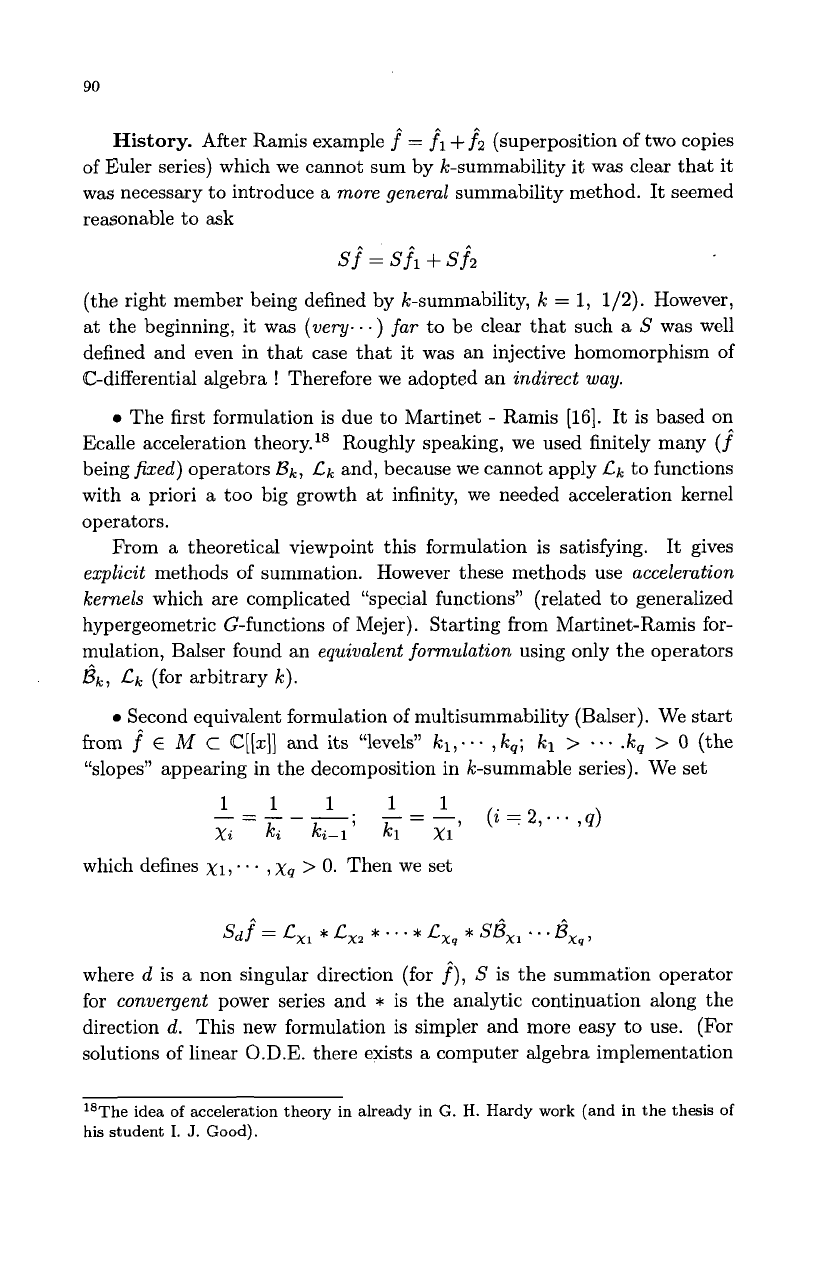
90
History.
After Ramis example
f
=
f1+
f2
(superposition of two copies
of Euler series) which we cannot sum by k-summability it
was
clear that it
was necessary to introduce a
more general
summability method.
It
seemed
reasonable to
ask
(the right member being defined by k-summability,
k
=
1,
1/2).
However,
at the beginning, it was
(very.
. .
)
far
to be clear that such
a
S
was well
defined and even in that case that it was an injective homomorphism of
@-differential algebra
!
Therefore we adopted an
indirect way.
0
The first formulation is due to Martinet
-
Ramis
[16].
It is based on
Ecalle acceleration the0ry.l’ Roughly speaking, we used finitely many
(f
being
fixed)
operators
Bk,
ck
and, because we cannot apply
ck
to functions
with a priori a too big growth
at
infinity, we needed acceleration kernel
operators.
From a theoretical viewpoint this formulation is satisfying.
It
gives
explicit
methods of summation. However these methods use
acceleration
kernels
which are complicated “special functions” (related to generalized
hypergeometric G-functions of Mejer). Starting from Martinet-Ramis for-
mulation, Balser found an
equivalent formulation
using only the operators
&,
ck
(for arbitrary
k).
0
Second equivalent formulation
of
multisummability (Balser). We start
from
f
E
M
c
@[[XI]
and its “levels”
til,..-
,
k,;
kl
>
-.-
.k,
>
0
(the
appearing in the decomposition in k-summable series). We set
which defines
XI,
. . .
,
X,
>
0.
Then we set
Sdf
=
c,,
*
cx2
*
‘ ‘
’
*
cxs
*
Sb,,
*.
.
6,*
,
where
d
is a non singular direction (for
f),
S
is the summation operator
for
convergent
power series and
*
is the analytic continuation along the
direction
d.
This new formulation is simpler and more easy to use. (For
solutions of linear
O.D.E.
there exists a computer algebra implementation
lsThe idea
of
acceleration theory
in
already in G.
H.
Hardy work (and in the thesis
of
his student
I.
J.
Good).
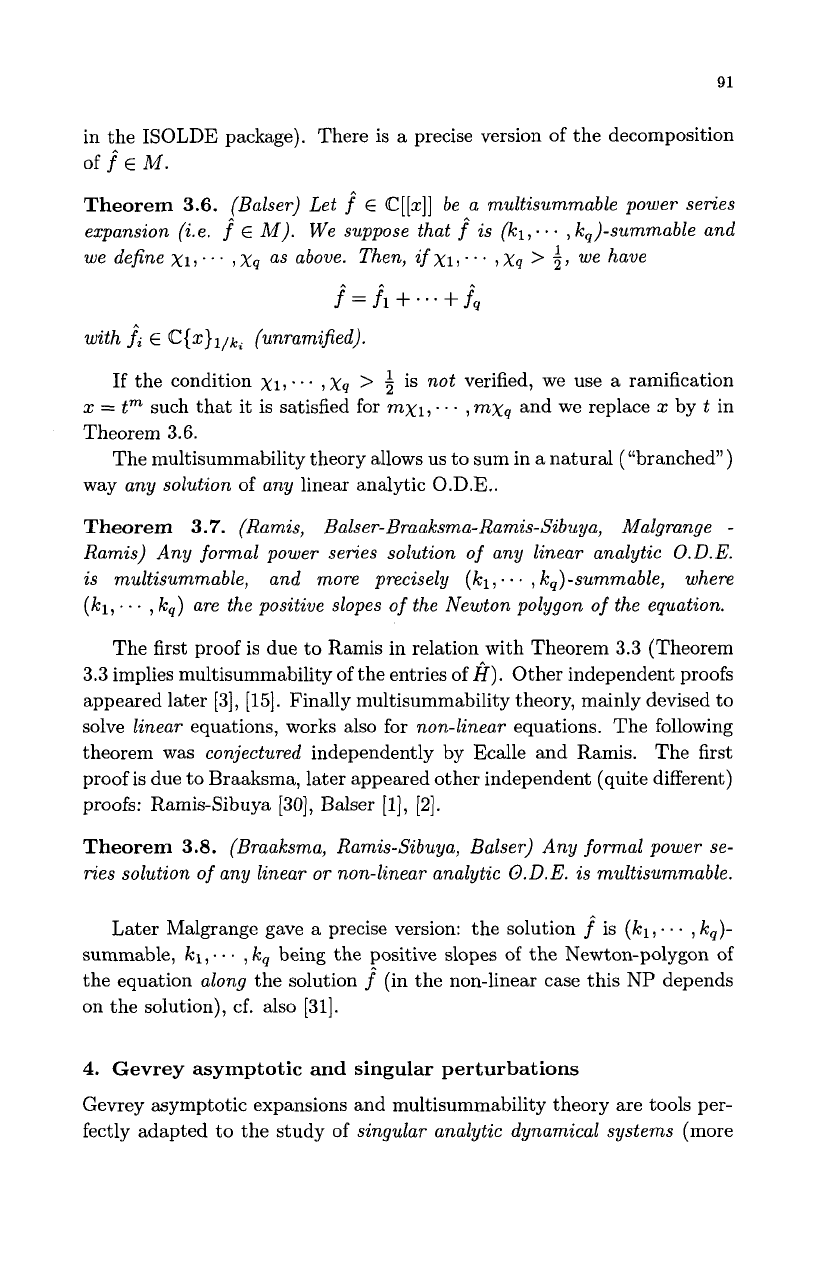
91
in the
ISOLDE
package). There is a precise version of the decomposition
OffEM.
Theorem
3.6.
(Balser) Let
f
E
C[[x]] be a multisummable power series
expansion (ie.
f
E
M).
We suppose that
f
is
(kl,.
.
.
,
k,)-summable and
we define
x1,
’.
.
,
x,
as
above. Then,
if
~1,.
. .
,
xq
>
3,
we have
1
p
=
fl
+
. . .
+
pq
with
fi
E
C{xC)l,k;
(unramified).
If the condition
XI,
-.
.
,
x,
>
is
not
verified, we use a ramification
x
=
tm
such that it is satisfied for
mX1,.
. . ,
mXq
and we replace
x
by
t
in
Theorem
3.6.
The multisummability theory allows us to sum in
a
natural (“branched”)
way
any solution
of
any
linear analytic
O.D.E..
Theorem
3.7.
(Ramis,
Baker-Braaksma-Ramis-Sz’buya,
Malgrange
-
Ramis) Any
formal
power series solution
of
any linear analytic O.D.E.
is multisummable, and more precisely (kl,
.
.
.
,
k,)-summable, where
(kl,
. . .
,
k,)
are the positive slopes
of
the Newton polygon
of
the equation.
The first proof is due to Ramis in relation with Theorem
3.3
(Theorem
3.3
implies multisummability of the entries of
A).
Other independent proofs
appeared later
[3],
[15].
Finally multisummability theory, mainly devised to
solve
linear
equations, works also for
non-linear
equations. The following
theorem was
conjectured
independently by Ecalle and Ramis.
The first
proof is due to Braaksma, later appeared other independent (quite different)
proofs: Ramis-Sibuya
[30],
Balser
[l],
[2].
Theorem
3.8.
(Braaksma, Ramis-Sibuya, Balser) Any
formal
power se-
ries solution
of
any linear
or
non-linear analytic O.D.E. is multisummable.
Later Malgrange gave a precise version: the solution
f
is
(kl,
. . .
,
k,)-
summable,
kl,.
. .
,
k,
being the positive slopes
of
the Newton-polygon of
the equation
along
the solution
f^
(in the non-linear case this NP depends
on the solution), cf. also
[31].
4.
Gevrey asymptotic and singular perturbations
Gevrey asymptotic expansions and multisummability theory are tools per-
fectly adapted to the study of
singular analytic dynamical systems
(more
